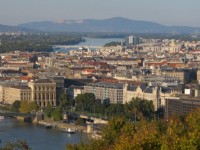Mary Jane Lawson and Rene Pentalone, Members of the I2UD Board
This year the I2UD Board of Directors explored 1000 km of the diverse Hungarian and Romanian country side travelling from Budapest, Hungary to Bucharest, Romania.
Starting in the historic Hungarian city of Budapest, perched on both sides of the beautiful Danube River, the city came alive when Dr. Katalin Pallai (an expert on Local Governance) guided us through a walking tour of the old neighborhoods. We were awed by the historic Parliament buildings, the unique Turkish baths, the cathedrals and synagogues and the elegant private villas, so rich in history and unique in their geographic setting. Dr. Pallai explained the challenges encountered in the transition from communism to democracy over the past 25 years and what that meant in redefining government and private housing and redesigning the urban landscape. After learning about this beautiful city we finished our stay in Budapest with much Goulash, wine and Hungarian music as we were privileged to celebrate professor Vigier’s 80th birthday with him.
On our way to Romania the next day we visited historic wine cellars in the Tokay wine region of Hungary where the viticulture tradition has existed for at least 1,000 years and where we tasted what King Louis XIV called the “King of all Wines”. Then we crossed the Hungarian border into the Romanian town of Oradea where we were met by an old friend, Dr. Andrei Luncan, the former Chief Architect of Oradea, who had worked with John Driscoll and the I2UD on many Romanian projects in the past. Dr. Luncan accompanied us for the rest of our trip in Romania and his knowledge, experience, and history with various villages and towns proved invaluable.
We were privileged to meet with the Deputy Mayor of Oradea and the new General Manager of the Oradea Metropolitan Area who thanked John Driscoll and Dr. Luncan for their early efforts in creating the framework for Metropolitan Oradea. The success of the program developed in Oradea has begun to spread to other municipalities in Romania and it was very encouraging for the Board Members to see how the efforts of the I2UD live on in a country even after the initial projects have been completed.
Continuing our tour we visited Sighisoara, Transylvania, a UNESCO World Heritage Site, infamous as the birthplace of Dracula. Then we travelled a short drive down the road to Viscri, an ancient Saxon village, at the foothills of the Carpathian Mountains where we explored the famous fortified church of Viscri, built in the 12th century. The local farm houses surrounding the village have been the recent recipients of funding from many organizations who have aided in their restoration and preservation. Some are now used as lodging for hikers and other tourists and are an example of how Romanians are thinking of new ideas to sustain their existence in these rural areas. Our next stop was the city of Sibiu, Romania which was awarded the European City of Culture in 2007. This designation is the design and urban planning equivalent of winning the bid for the Olympics and the resultant face lift that the city underwent for the events in 2007 helped to emphasize the uniquely European flare in its architecture and culture. What a varied and beautiful country Romania is.
Leaving Sibiu we embarked on a spectacularly scenic drive through the Carpathian Mountains, finally entering the resort town of Sinaia. This is the home of the overwhelmingly ornate Peles Royal Castle, summer home of the Romanian Royal Family for decades, and other beautiful historic buildings. Unfortunately, during the Communist Era large and unattractive egalitarian hotels were built that remain to this day, giving the town the feeling of a poorly planned tourist destination.
It was in Sinai, a town which seemed to represent both the best and worst of architectural design and planning in Romania, where we participated in the I2UD Seminar on Urban and Regional Challenges and Opportunities in Romania. Presentations were made by various members of the Romanian Ministry of Regional Development and Tourism, the President of the Romanian Register of Urban Planners and our own Professor Frank Vigier. Many of our Board Members shared their own experiences of developing land and doing business in Canada and the United States. A stimulating discussion of life in the new urban Romania, with its goal to be a vital player on the eastern European and world markets led to further analysis of the effect of post Communism politics on the urban landscape and expansion throughout Romania.

After the Seminar we headed for Bucharest, the largest and most prosperous city in Romania. The city’s elegant architecture, so reminiscent of Paris, had long ago earned it the nick name of “Little Paris”. Today the city is the centre of Romanian mass media, culture and arts. In addition, Bucharest is one of the main industrial centers and transportation hubs of Eastern Europe. Here the Board held its final meeting and goodbye dinner in the company of Professor Liviu Inasi, Secretary, Romanian Professional Association of Urban Planners, who gave us first hand accounts of the tumultuous transitions that have occurred in Romanian cities and society over the past 30 years. Once again the Board Members were pleased to hear how the I2UD had participated in the transitions the country and its cities have made. We also came to understand that the unending dedication of citizens like Dr. Katalin Pallai, Andrei Lucan and Liviu Inasi has helped Romania reach its full potential as a player in the world markets.
Thank you to Professor Frank Vigier, John Driscoll, and Mary Shia for all the hours of planning and preparing for this exceptional trip from Budapest to Bucharest!

